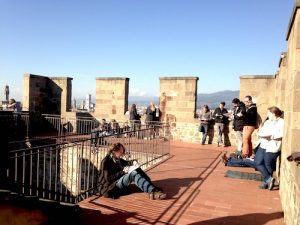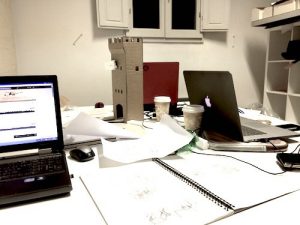 A collaborative workshop
A collaborative workshop
The collaboration between ISI Florence and TU Delft (RMIT) sprouted once again in the Spring 2015 semester. On February 2-7, the Architecture Studio on the third floor of Palazzo Bargagli hosted the collaborative design workshop, “Torre San Niccolò: A palimpsest for urban tactics.”
The week-long design workshop was organized as a collaboration between the honours program of the Architecture Dept. at Delft University of Technology (RMIT), led by Dr. Marie-Thérèse van Thoor and Ir. Alexander de Ridder, and the ISI Florence Architecture Program led by Arch. Franco Pisani (ARCH 320: Architecture Design Studio VI and IARC 320: Interior Architecture Design Studio VI) with the support of NIKI, “Istituto Universitario Olandese a Firenze” (Dr. Michael Kwakkelstein).
Students, organized in mixed groups, were asked to develop ideas and proposals for the urban retraining of the former gate of San Niccolò, during a four-day design workshop in which they worked on on-site assignments as well as on design proposals.
“We loved our stay in Florence and working on the San Niccolò tower workshop with Franco and his students from Marywood University and our students from the TU-Delft. The site visits to the tower, the lectures, conversations with students, the workshop and final presentations at NIKI were all great. We were all enthusiastic about the program, especially about the production and level of the works by students. We wish to thank ISI Florence and Prof. Pisani for all the effort they have put into this extraordinary collaboration.”
Marie-Thérèse Van Thoor, Alexander de Ridder, TU Delft
“I really loved the workshop! I found it very inspiring and it was really nice to work with students from other countries. The combination of lectures, excursions and design workshop was really good. It was a lot of work, but doable and fun because of the diversity of the content!”
Bob Hendrix.
“It was a compact and intense week with the workshop of the San Niccolò tower in Florence. During this week we developed different plans for the transformation of this former city gate; in just a couple of days, very different but interesting solutions were found. The collaboration between TU Delft and ISI Florence was invigorating. As students from Delft and America we worked together and, though we use different approaches and methods, the joint-venture was instructive for all of us. Also, the context of an architectural re-use assignment in the beautiful and inspiring historic center of Florence made us aware of the value of buildings, culture and identity. Thanks a lot for this great experience!”
A. van Deursen BSc, MA-student Arts&Culture at Leiden University, MSc-student Architecture at Delft University of Technology.
Guest lectures
Claudio Sgarbi, Ph.D., is a practicing Architect and Adjunct Research Professor at the Azrieli School of Architecture and Urbanism at Carleton University. For the last twenty years he has been working as a technical director for different building firms in Italy, where he supervises and directs new constructions and the renovations of existing buildings. He has published several articles, essays, and a book: “Vitruvio Ferrarese. De Architectura. La Prima Versione Illustrata” (Franco Cosimo Panini Editore, 2004).
During his lecture, Sgarbi will tell our students the legend of the master builder Manole. Between history and myth, spanning from archaic times to modernity, this story is about a body hidden in a wall.
Alessandro Ayuso recently completed his Ph.D. at the Bartlett School of Architecture with a thesis entitled “Body Agents: Figures as Agents for Design.” Alessandro received his Bachelor of Architecture from Virginia Tech, and studied urban design at the Syracuse University Florence program. He has taught, lectured, and sat as a critic at numerous universities. After working in professional design practices in New York, he has recently co-founded the Agency for Interior Urbanism, a platform for investigating alternative strategies for urban design.
Ayuso will give a lecture based on his research on body agents and tell our students a few fictional stories from the viewpoint of a 579 year old putto who witnessed the historic Baroque era. Intellectual yet theatrical, playful but consumed with memories of “lost opportunities” and “missed roles,” we will discover Putto 1435, an unreliable narrator.


